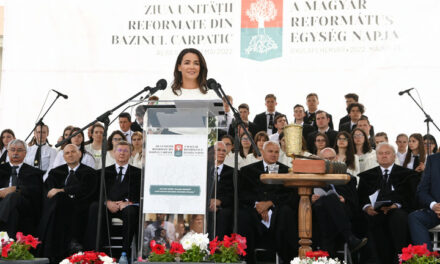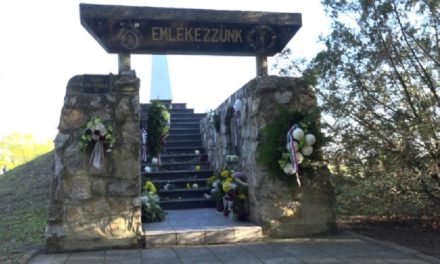Following the Treaty of Trianon, which ended the First World War, many art treasures were transferred to the new neighboring states together with the separated territories.
March 15 is not only the anniversary of the outbreak of the Hungarian Revolution and War of Independence in 1848-1849, but also the opening of the Arad Relic Museum: 131 years ago on this day, the collection of relics was opened for the first time, which forms the basis of today's Arad County Museum.
This is now also recognized by the local Romanian cultural policy, even if at the moment only one of its permanent exhibits is the museum's collection of the personal belongings of the 13 martyrs.
It is a novelty that after the renovation that lasted almost a year, the Relic Museum in the city on the Maros coast can be visited again from the first of March, in which Zsigmond Aradi's sculpture "Búsuló Arad" was once again made a public treasure after 92 years. But the Gallery, which preserves the paintings of world-famous Hungarian artists, has also been expanded with new works and an exhibition hall. It was transferred to Arad as a depository of the Fine Arts Museum in Budapest, and is based on works left here after the First World War, including art historical rarities.
Twenty years ago, with the restoration of the Statue of Liberty in the public square, the Romanian authorities in Arad became more accepting of Hungarian-related monuments.
Since then, the Trinity statue in front of the theater has been restored, in 2015 a permanent exhibition was organized from the collection of the Relic Museum of 1848-1849, and the relic collection, founded in the 19th century and still operating today, was recognized as the legal predecessor of today's Arad County Museum. It was created at the initiative of an association. (Last year, on the 130th anniversary of the museum's foundation, the managers of the museum and the heads of the county council that maintains the institution openly assumed legal continuity.)
In May 2022, the Art Gallery of the works of world-famous Hungarian painters was opened again in the Palace of Culture in Arad, which houses the museum.
The central element of the permanent exhibition is Árpád Feszty's monumental triptych, The Burial of Christ. Árpád Feszty was a master of monstrous images, and although the triptych does not measure up to the panorama The Arrival of the Magyars exhibited at Ópusztaszer, it is special both because of its subject matter and its dimensions.
The monumental painting, 13 meters long and 4 meters high, was painted by Árpád Feszty in Florence, exhibited in Budapest in 1903, and then went on an international tour.
The first picture of the triptych depicts the death of Jesus on the cross, the second oil painting shows the funeral procession, while the third shows the tomb with Mary lying on the ground. When the Palace of Culture opened in 1913, it came to Arad as a deposit of the Museum of Fine Arts, together with about a hundred other pictures, of which the first exhibition was opened.
Following the Treaty of Trianon, which ended the First World War, many art treasures were transferred to the new neighboring states together with the separated territories.
This is how the triptych became the property of the Arad museum, where it was displayed until the end of the 1950s, after which it was covered up, and in 1962, the communist government banished the biblical-themed work of art to storage.
Last May - on the first anniversary of the reopening - they started renovating the exhibition halls, and at the same time expanded the collection, which had been closed until now, with new locations and works.
At the reopening of the collection of the Art Gallery and the Relic Museum on March 1 this year, Iustin Cionca, chairman of the Arad County Council, called the removal of Hungarian-related monuments and works of art decades ago a mistake.
“I feel sorry for the generations who lost because these works were inaccessible to them. For whom this slice of Arad's history was encrypted and mystified. These works of art can be a source of pride for every individual of Arad, and for the entire community," declared the Romanian council president.
According to the government representative of Arad county, RMDSZ prefect Csaba Tóth, the Arad Palace of Culture was able to fulfill its mission 110 years after its inauguration, i.e. to become a real center of public education, regardless of nationality.
"Twenty years ago I was a county councilor - then it would not have been possible to do this. I am glad that the current managers of the county government and the museum, as well as the councilors of the RMDSZ, are people who dared to dream of this and brought it to fruition. In addition to the fact that this is a source of pride for us, the Hungarians of Arad, I am sure that tourism will also be boosted by the pictures exhibited here, and there will not be a Hungarian who travels to Transylvania and does not visit Arad," explained the prefect.
Just as the original Kölcsey Association, which was established to organize and support public culture in the founding of the museum and in the construction of the Palace of Culture, achieved timeless merits, the re-opening of the (Hungarian) Gallery and the exhibition of the Feszty picture, which was banned during communism and then re-established after the change of regime, is the persistence of the current leadership of the Kölcsey Association. result. In March 2016, they announced that they would initiate the restoration and permanent exhibition of the Burial of Christ, and were heard and supported by the county and city authorities.
The triptych rolled on coils was unrolled for a year, and to the astonishment of those present, Sándor Lizen-Mayer's painting King Matthias, thought to be lost, was also removed from the cylinders (it is also a monumental work, 5x4 meters, and can be viewed in the Gallery).
After the restoration in Sibiu and the restoration of the original exhibition hall on the second floor of the museum (among other things, the renovation of the glass dome providing natural light), the Gallery was able to open almost two years ago.
"Seventy to eighty pictures remain here from the Museum of Fine Arts - because twenty pieces were brought back to Budapest in January 1919 - most of them can be seen. But the exhibition does not only include the deposited material: there are also purchased and nationalized pictures among them", stated Károly Fekete, the art-loving and connoisseur vice-president of the Kölcsey Association, along with others Mihály Munkácsy, Gyula Benczúr, Károly Wolff, Than Mór and About a collection boasting pictures by Károly Lotz.
In the early evening of the first of March, more than a hundred interested people - mostly Hungarians from Arad - could still see traces of the restoration work here and there in the corridors of the museum, but since then the smell of paint has disappeared, and the last drops of paint have been wiped away.
The exhibition rooms on the second floor open from each other, so the visitor can reach the Art Gallery through the collection of the Relic Museum. At the exhibition of the Relic Museum, the viewer immediately "stumbles" upon the sculpture "Haunting Arad", which has languished in the museum's warehouse for 92 years.
Zsigmond Aradi's statue made of Carrara marble commemorates the victims of the street fighting in Aradi on February 8, 1849.
At that time, in addition to the Austrian regular troops, the Serbian counter-revolutionaries attacking from the South devastated the city, and the Home Guards - who, according to legend, were encouraged to fight by First Lieutenant Sándor Asztalos and the then elderly government commissar Dániel Boczkó with their walking sticks - succeeded in driving out the enemy only at the cost of bloody casualties.
"It was Arad's saddest day in the revolution. They looted, robbed, murdered, there were heaps of corpses in the city, and in addition to the many civilian victims, about 250 soldiers were killed, recalled Károly Fekete. "Nevertheless, when it was erected on February 8, 1873, when many old veterans who suffered that day were still alive, they did not erect a sword-rattling statue announcing victory, but a humble statue symbolizing sadness that such a tragedy could happen..."
The statue was placed at the northern end of Andrássy tér (today's main square), opposite the theater, then with the expansion of the city it was moved to the old military cemetery, and when it was liquidated (today's Officers' Colony was built in its place), it was included in the museum's storage.
"Fortunately!" - stated Arad sculptor Rudolf Kocsis, who restored the Búsuló Arad.
"If it hadn't been taken away, there would have been nothing to restore," said the artist, who created several public works in Arad. The statue's face was smashed with a hammer, an unidentified black substance was poured over its head and burned, so that it could only be removed by scraping square millimeter by square millimeter. "Also, it was a fantastic feeling to work on such an old statue. The hand and the crown are missing, but it will remain so, because it is a trace of history. I strove for the opposite restoration, to emphasize the nose, eyes, mouth, toes, and the details of the drapery, but I did not replace the broken parts," said Rudolf Kocsis, adding that he had "brought" the statue to a condition that could be exhibited for the time being, but two months later there is still work to do.
Zsigmond Aradi was the first Hungarian artist - he was born in Arad under the name Landshut, and one of his Petőfi reliefs can be seen in the corridor of the Gergely Csiky High School in Arad - in the 19th century, who maintained a workshop in Italy.
He created the Búsuló Arad in Milan, and it was originally called Busongó Róma, then it became a Honvéd monument, and finally it was preserved as the commonly remembered Búsuló Arad.
The main event of the opening held at the beginning of the month was the unveiling of the statue, but the personal belongings of the 13 army officers executed in Arad and other soldiers held in the castle prison can be seen on the walls, along the walls and in the display cases. The opportunity to cherish the memory of the revolution and the 13 army officers executed in Arad opened in 1867, after the Austro-Hungarian Compromise.
At the initiative of the Kölcsey Association, a collection was organized for the creation of a relic museum, which was finally opened on March 15, 1893, in the second floor corridor of the theater.
Over the years, the Museum of Relics has expanded to 17,000 pieces, after the Budapest National Museum and the Institute and Museum of Military History, the third largest '48 collection, stated earlier the Szeged historian Péter Zakar, who also participated in the cataloging of the collection in 2008-2009. A permanent exhibition of the relics banished to the depths of the warehouses in 1974 was opened again in October 2015, but only a part of the entire collection can be seen due to space constraints.
Apart from the most recent renovation, which lasted almost a year, it has been open for viewing since then, and has become one of the destinations for tourists visiting Arad, mainly from Hungary.
At the time of the restoration, only the most persistent could view the collection, but now it can be visited during the museum's opening hours - with the exception of Mondays - without an "intervention".
Cover image: Árpád Feszty's triptych presents a fascinating sight in the Arad Gallery
Source: Zsolt Lehel Pataky/Krónika.ro













